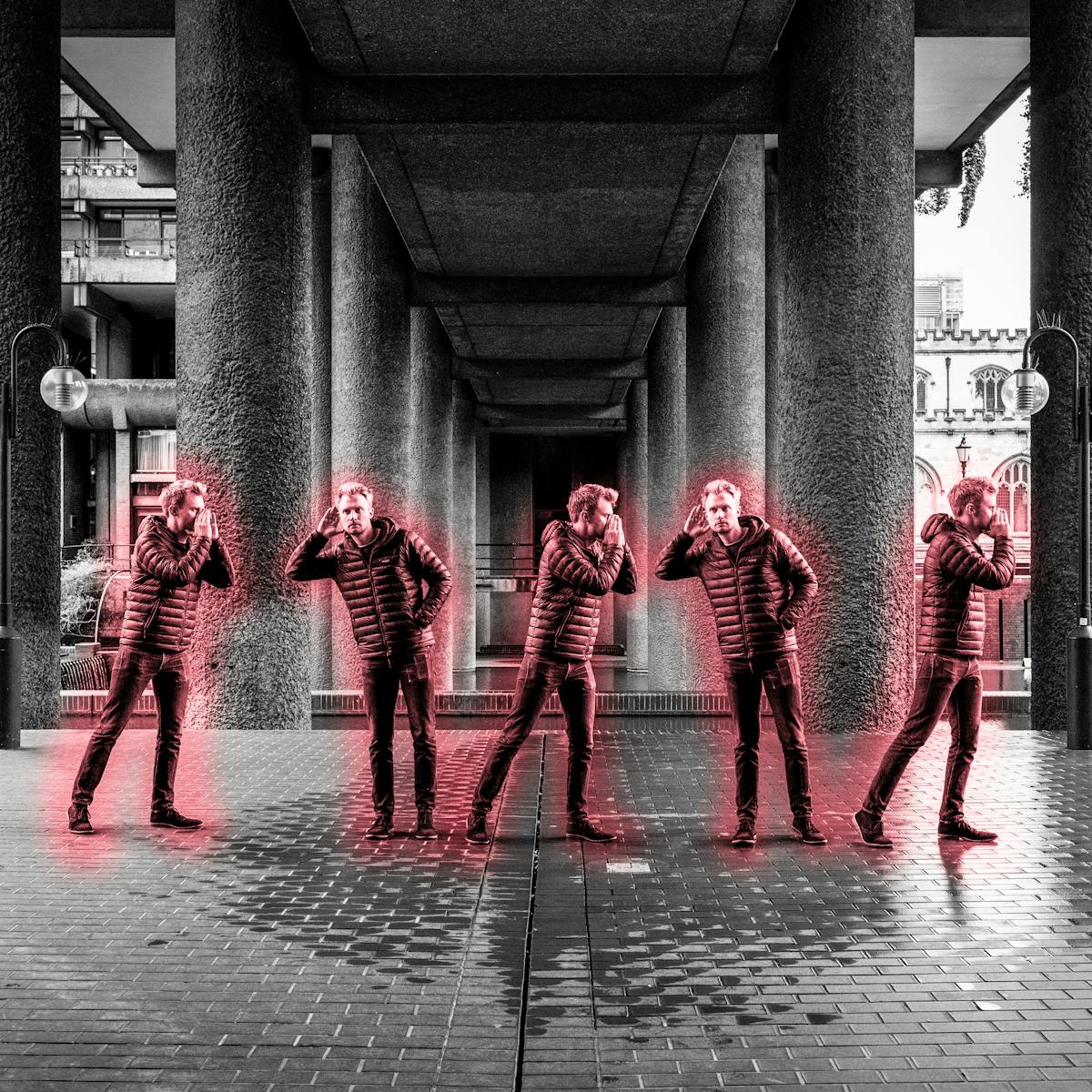When we think of contagion, we tend to think about infectious diseases or viral online content. But, as epidemiologist Adam Kucharski reveals, outbreaks can come in many forms. In this extract from ‘The Rules of Contagion’, the author argues that it’s time to rethink infection.
The science of why things spread
Words by Adam Kucharskiphotography by Camilla Greenwellaverage reading time 7 minutes
- Book extract

A few years ago, I accidentally caused a small outbreak of misinformation. On my commute to work, a friend who works in tech had sent me a stock photo of a group hunched over a table wearing balaclavas. We had a running joke about how news articles on computer hacking would often include staged pictures of people looking sinister.
But this photo, below a headline about illicit online markets, had taken things much further: as well as balaclavas, there was a pile of drugs, and a man who apparently wasn’t wearing any trousers. It seemed so surreal, so inexplicable.
I decided to tweet it. “This stock photo is fascinating in so many ways,” I wrote, pointing out all the quirks in the image. Twitter users seemed to agree, and within minutes dozens of people had shared and liked my post, including several journalists.
Then, just as I was starting to wonder how far it might spread, some users pointed out that I’d made a mistake. It wasn’t a stock photo at all; it was a still image from a documentary about drug dealing on social media. Which, in retrospect, made a lot more sense (apart from the lack of trousers).
Popular online content tends to start with a ‘broadcast’ event that exposes lots of people (for example, a headline or celebrity tweet), then it spreads further among small friendship groups.
Somewhat embarrassed, I posted a correction, and interest soon faded. But even in that short space of time, almost 50,000 people had seen my tweet. Given that my job involves analysing disease outbreaks, I was curious about what had just happened. Why did my tweet spread so quickly at first? Did that correction really slow it down? What if people had taken longer to spot the mistake?
Outbreaks and the unexpected
When we think of contagion, we tend to think about things like infectious diseases or viral online content. But outbreaks can come in many forms. They might involve things that bring harm – like malware, violence or financial crises – or benefits, like innovations and culture. Some will start with tangible infections such as biological pathogens and computer viruses, others with abstract ideas and beliefs.
Outbreaks will sometimes rise quickly; on other occasions they will take a while to grow. Some will create unexpected patterns and, as we wait to see what happens next, these patterns will fuel excitement, curiosity, or even fear. So why do outbreaks take off – and decline – in the way they do?
Doubling is the way an outbreak grows in its early stages. For pandemic flu, each case on average infects a couple of others initially, so we’d expect one case, then two, then four, then eight, and so on.
Looking for patterns
Three and a half years into World War I, a new threat to life appeared. While the German army was launching its Spring Offensive in France, across the Atlantic people had started dying at Camp Funston, a busy military base in Kansas. The cause was a new type of influenza virus, which had potentially jumped from animals into humans at a nearby farm.
During 1918 and 1919, the infection would become a global epidemic – otherwise known as a pandemic – and would kill over 50 million people. The final death toll was twice as many as World War I.
Over the following century, there would be four more flu pandemics. This raises the obvious question: what will the next one look like? Unfortunately it’s difficult to say, because previous flu pandemics were all slightly different. There were different strains of the virus, and outbreaks hit some places harder than others. In fact, there’s a saying in my field: “if you’ve seen one pandemic, you’ve seen… one pandemic.”
We face the same problem whether we’re studying the spread of a disease, an online trend, or something else; one outbreak won’t necessarily look like another. What we need is a way to separate features that are specific to a particular outbreak from the underlying principles that drive contagion. A way to look beyond simplistic explanations and uncover what is really behind the outbreak patterns we observe.
Sometimes social behaviour has nothing to do with social connections. Like when it rains, people start to open umbrellas. They aren’t necessarily reacting to each other; they’re reacting to the clouds above.
The shape of an outbreak
When disease researchers hear about a new threat, one of the first things we do is to draw what we call an outbreak curve – a graph showing how many cases have appeared over time.
Although the shape can vary a lot, it will typically include four main stages: the spark, growth, peak, and decline. In some cases, these stages will appear multiple times; when the ‘swine flu’ pandemic arrived in the UK in April 2009, it grew rapidly during early summer, peaking in July, then grew and peaked again in late October.
It’s increasingly possible to measure and compare contagion across industries, using ideas from one area of life to help us understand another.
Despite the different stages of an outbreak, the focus will often fall on the spark. People want to know why it took off, how it started, and who was responsible. In hindsight, it’s tempting to conjure up explanations and narratives, as if the outbreak was inevitable and could happen the same way again. But if we simply list the characteristics of successful infections or trends, we end up with an incomplete picture of how outbreaks actually work.
Most things don’t spark: for every influenza virus that jumps from animals to humans and spreads worldwide as a pandemic, there are millions that fail to infect any people at all. For every tweet that goes viral, there are many more that don’t.
Even if an outbreak does spark, it’s only the start. Try and picture the shape of a particular outbreak. It might be a disease epidemic, or the spread of a new idea. How quickly does it grow? Why does it grow that quickly? When does it peak? Is there only one peak? How long does the decline phase last?
In social network theory, a ‘bridge’ is a social relationship that connects two different groups who would otherwise not interact.
Collaboration and challenge
These issues are relevant to many industries, from finance and politics to technology and health. My wife works in advertising; while my research aims to stop disease transmission, she wants ideas and messages to spread. Although these outlooks seem very different, it’s increasingly possible to measure and compare contagion across industries, using ideas from one area of life to help us understand another.
Our understanding of contagion has transformed in recent years, and not just in my field of disease research. With detailed data on social interactions, researchers are discovering how information can evolve to become more persuasive and shareable, why some outbreaks keep peaking – like the 2009 flu pandemic did – and how ‘small-world’ connections between distant friends can help certain ideas spread widely (and yet hinder others).
At the same time, we’re learning more about how rumours emerge and spread, why some outbreaks are harder to explain than others, and how online algorithms are influencing our lives and infringing on our privacy.
As a result, ideas from outbreak science are now helping to tackle threats in other fields. Central banks are using these methods to prevent future financial crises, while technology firms are building new defences against harmful software. In the process, researchers are challenging long-held ideas about how outbreaks work.
Researchers have often used experiments that reproduce the child’s game of ‘whispers’ to study how information spreads.
Finding what drives contagion
When it comes to contagion, history has shown that ideas about how things spread don’t always match reality. Medieval communities, for example, blamed the sporadic nature of outbreaks on astrological influences; influenza means ‘influence’ in Italian.
Popular explanations for outbreaks continue to be overturned by scientific discoveries. This research is unravelling the mysteries of contagion, showing us how to avoid simplistic anecdotes and ineffective solutions.
But despite this progress, coverage of outbreaks still tends to be vague: we simply hear that something is contagious or that it’s gone viral. We rarely learn why it grew so quickly (or slowly), what made it peak, or what we should expect next time.
Whether we’re interested in spreading ideas and innovations, or stopping viruses and violence, we need to identify what’s really driving contagion. And sometimes, that means rethinking everything we thought we knew about an infection.
‘The Rules of Contagion’ is out now.
About the contributors
Adam Kucharski
Adam Kucharski is an associate professor and Sir Henry Dale Fellow at the London School of Hygiene & Tropical Medicine, working on global outbreaks such as 2019-nCoV, influenza and Zika. He is a TED senior fellow and winner of the 2016 Rosalind Franklin Award Lecture and the 2012 Wellcome Trust Science Writing Prize. He has written for the Observer, Financial Times, Scientific American, and New Statesman. He is also the author of ‘The Perfect Bet: How Science and Maths Are Taking the Luck Out of Gambling’.
Camilla Greenwell
Camilla Greenwell is a photographer specialising in dance, performance and portraiture. She regularly works with Sadler’s Wells, Barbican, Candoco, Rambert, The Place, the Guardian, the British Red Cross, Art on the Underground and Wellcome Collection.

